Celebrating Holi in India | Holi: Indian Color Festival
India is a country thriving with diverse cultures, each with their distinct traditions, festivals, and heritage. Festivals add color and variety to our monotonous life. They bring everyone together, omitting all the differences.
One festival that enwraps entire North India in its myriad colors is Holi!
Every year Holi or the ‘Festival of Colors’ is observed in the month of Phalgun, that is sometime in the first week of March. Choti Holi is celebrated on the eve of Poornima(full moon), with ‘Holika Dahan’ and the next day, people celebrate Holi with lots and lots of colors. In fact, this Hindu festival of colors has become so famous that it grand Holi celebrations are not only in India, but all across the world including Jamaica, Guyana, Trinidad and Tobago, South Africa, Malaysia, UK, the United States, Canada, and Mauritius. It has become a worldwide symbol of love, peace, and merriment.
Significance And Myth Behind The Celebration of Holi
The festival of colors has a deep symbolic meaning – it marks the triumph of good over evil. It is held in honor of Lord Vishnu and his dedicated bhakt, Prahlad.
According to a legend in the Bhagavata Purana, the demon king Hiranyakashyap was blessed with a boon by the Gods – he could neither be killed by a human nor an animal; neither indoors or outdoors; neither during the day or during the night; neither with a projectile nor a handheld weapon; neither on land, nor air or water. This made Hiranyakashyap extremely proud of his powers. He considered himself to be immortal and demanded that everyone, including the Gods, should worship him.
Hiranyakashyap had a son named Prahlad who was a devotee of Lord Vishnu. Despite all his attempts to stop Prahlad from worshipping Lord Vishnu, Hiranyakashyap failed miserably. And this infuriated him to the core that his own son refused to worship him and revered a God instead. He had made many attempts to kill Prahlad but was unsuccessful. Lord Vishnu was always there to protect Prahlad and render all of Hiranyakashyap’s plans futile.
However, Hiranyakashyap wasn’t ready to give up. So, along with his sister Holika, Hiranyakashyap made a plan to kill Prahlad. Holika was blessed with a boon that fire shall never burn her. Trying to take advantage of this blessing, Holika persuaded Prahlad to sit on her lap when she entered a pyre. To everyone’s surprise, Prahlad remained unscathed while Holika was burnt to ashes. Lord Vishnu rescued Prahlad once again.
Later, Hiranyakashyap was killed by Lord Vishnu who came as Narasimha, a Vishnu avatar that was half human and half lion.Narasimha (neither human nor animal) dragged the arrogant Hiranyakashyap to the doorstep ((neither indoor or outdoor) and killed him with his claws (neither projectile nor a handheld weapon). So, eventually good always triumphs over evil.
Holika Dahan in the eve of Choti Holi symbolizes this triumph of the good.
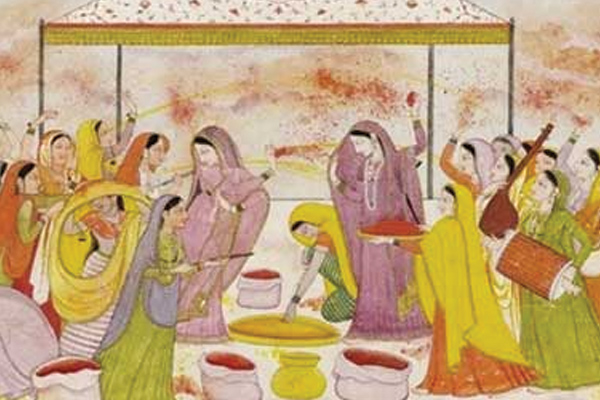 Lathmar Holi
Lathmar Holi
Although Holi is celebrated all over North India, the most glorious celebration of Holi is held in Krishna’s birthplace Mathura. Here, the people rejoiced in Holi celebrations for sixteen long days! According to legend, Holi was the result of one of Lord Krishna’s supreme pranks. When Krishna was a baby, he had been poisoned by Putana, a Demon, which caused his skin color to transform into a dark-bluish hue. His skin color constantly bothered him as he thought that the fair-skinned Radha would never like him. To end Krishna’s despair, his mother asked him to color Radha’s face in any color he wanted. So, every year, Krishna would travel from his village Nandgaon to Radha’s village, Barsana, to color her and her friends. The war of colors between Krishna and his friends and the women of Barsana took a playful turn – as the men threw colors at them, the women of Barsana would retaliate by playfully hitting them with sticks. Thus, began the legendary tradition of “Lathmar Holi.”
This Leela between Krishna and Radha symbolizes their love, and thus, Holi is also a festival commemorating their eternal love for each other.
The tradition is still very much alive in Uttar Pradesh. The celebration of Lathmar Holi begins seven days before Holi. Men and women from all across the Mathura district come together to reenact the epic story of the eternal love between Krishna and Radha. Every year, men from Nandgaon come to Barsana, in keeping with the tradition of Lathmar Holi. The celebrations commence in the Radha Rani temple where a ritual ceremony is held. After this, all the men and women gather in the famous ‘Rang Rangeeli Gali’ near the temple complex. While the men continuously tease the women of Barsana amidst the beat of dhols and songs, the women retaliate by hitting the men with lathis (sticks).
In case a man is caught and surrounded by the women folks, he must endure the playful beatings the women shower on him, for it is a custom that men cannot retaliate on this day. But the punishment does not end there – the man who gets caught by the womenfolk has to wear costumes of a woman and dance to the tunes of the songs! It sure is a sight to watch!
Amidst the chaos of colors and water sprays, people enjoy Bhang and sweet delicacies. As the Bhang starts to take hold of the folks, there begins another round of madness with people running wild – some laughing hysterically, some displaying their dancing skills, and some even crying! No wonder that this festival is so enjoyable and overwhelming and fun.
The mystical tales of Lathmar Holi has traveled far and wide, and today, the town of Barsana often sees a large crowd of foreigners who gather just to witness this epic battle of colors between the men and women.
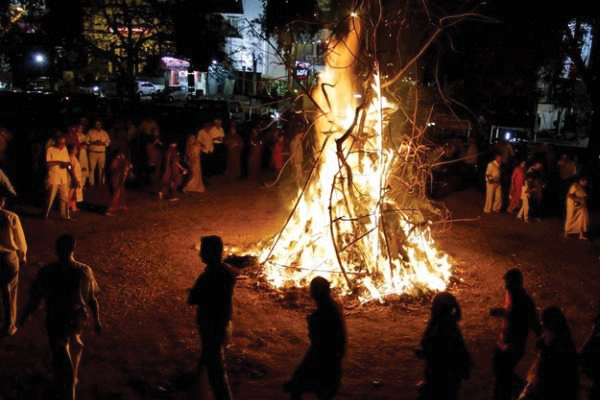
Holi Celebration
Social gatherings mark the two-day celebration of Holi amidst a lot of fun and merriment. On Choti Holi, people gather around the pyre for Holika Dahan and engage in singing and dancing to the tunes of the dholak. In the pyre is placed a pot of newly harvested barley seeds. These seeds are consumed by the people once the fire burns out. As the festival marks the beginning of Spring, priests make predictions about the harvest for the year seeing the condition of the burnt seeds and the direction of the flames of the pyre.
Every street in every town and village comes alive with the cacophony of happy faces, smearing each other with vibrant colors. Everywhere you look, you will find colorful faces smiling and laughing, sharing the joy of Holi. People all across the country revel in merriment by throwing colored flowers, dry colors, and watercolors at one another. Holi is not just about colors. It is also about indulging in delicious traditional Indian sweets and delicacies. Here are some of the most mouth-watering treats prepared during Holi.
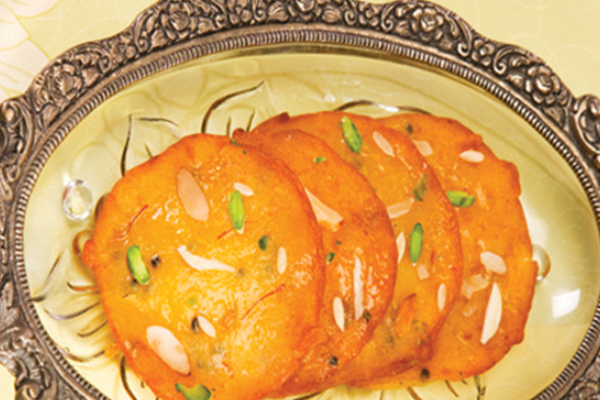
Malpua
Holi without this sweet dish cannot be imagined! Made from milk, flour, and sugar, Malpuas are deep fried sweets topped with assorted nuts and kheer. Need we say more?
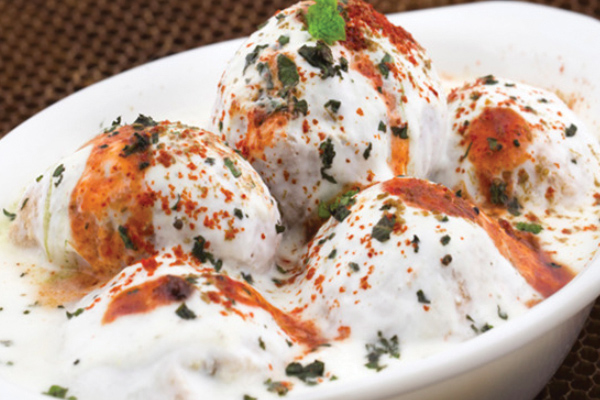
Dahi Vada
Dahi vada is a sweet and sour preparation. Fried urad dal dumplings are soaked in a creamy mixture of yogurt and tamarind chutney, and sprinkled with chaat masala and cumin powder on top. With a burst of so many flavors in one, this dish is pure love!
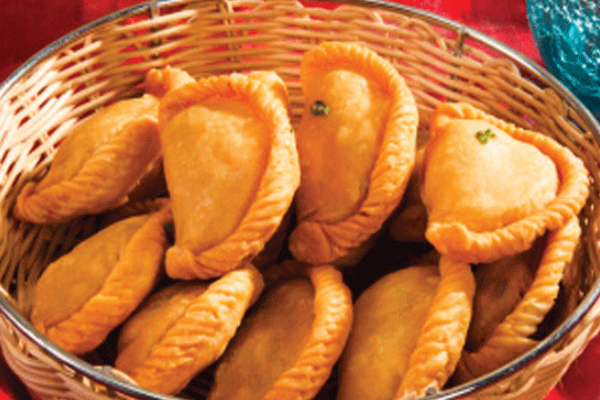
Gujiya
Gujiya is a deep fried sweet dumpling stuffed with khoya and dry fruits. As you take a bite, the delightful flavors of ghee, nuts, and khoya enliven your taste buds and trust us when we say, you cannot stop at one!
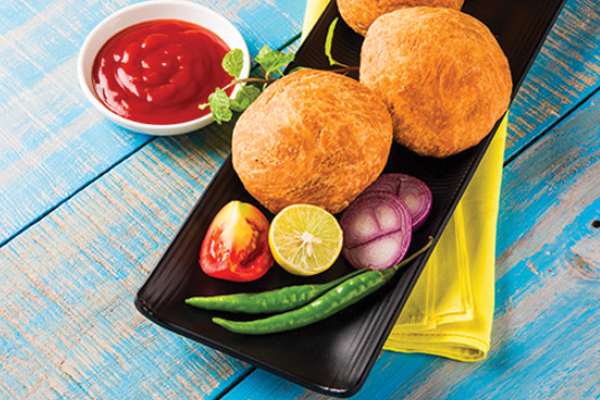
Moong Dal Kachori
Moong dal kachori is a scrumptious spicy and crispy preparation that is served with a variety of delicious chutneys. Made from soaked and sauteed moong dal, the blend of black pepper, garam masala, and coriander powder impart a unique flavor to this snack.
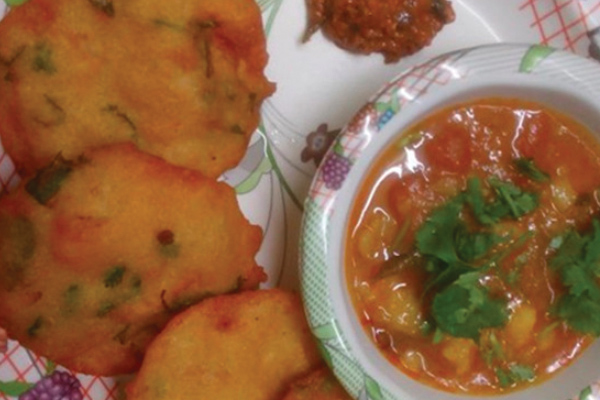
Dhuska
A popular Holi snack in Bihar and Jharkhand, Dhuska is a simple snack made from rice flour and chana dal. Served with chutney and spicy aloo curry, Dhuska is a must try!
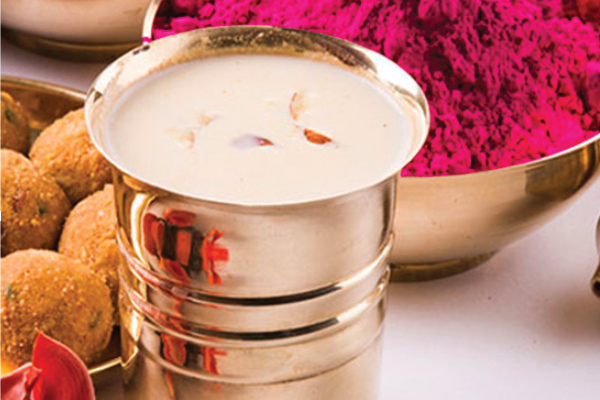
Bhang
Holi is incomplete without this sinful drink! Prepared with milk, spices, and a generous combination of dry fruits, Bhang is what you need to let loose during Holi. Don’t be deceived by its simple looks – even half a glass is strong will bring alive the party animal in you!
Drooling, right?
The festival of colors celebrates love, brotherhood, and unity. It shows us that barriers cannot hold people back when they all come together to commemorate something bigger than all of us – love and devotion. The essence of Holi has been beautifully captured in the 7th-century play Ratnaval:
“Witness the beauty of the great cupid festival which excites curiosity as the townsfolk are dancing at the touch of brownish water thrown from squirt-guns. They are seized by pretty women while all along the roads the air is filled with singing and drum-beating. Everything is colored yellowish red and rendered dusty by the heaps of scented powder blown all over.”
Yes, there’s indeed something extraordinary about Holi that makes everything around us seem so vibrant and colorful. So, let yourself free and go wild with colors in the Festival of Colors!
If you are interested in a tour to see the Holi Festival, contact us or give us a call 1.800.515.3808. A travel specialist would love to help you see the Holi Festival packaged in an unforgettable tour to India.
